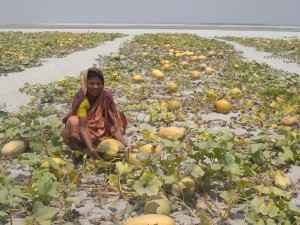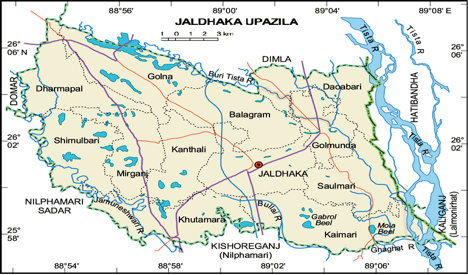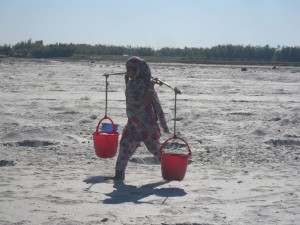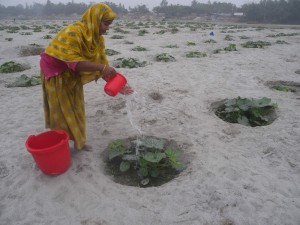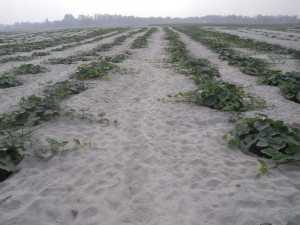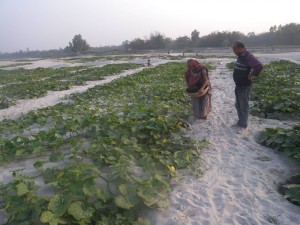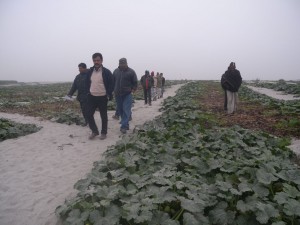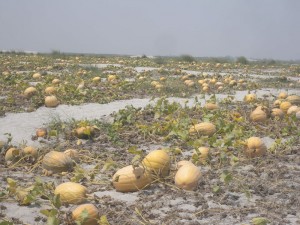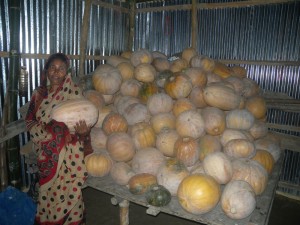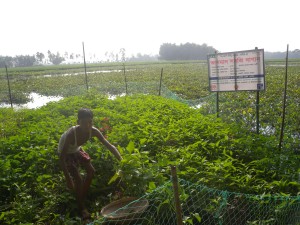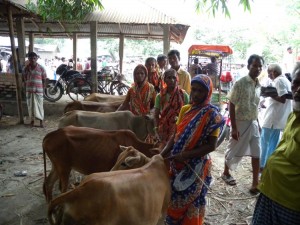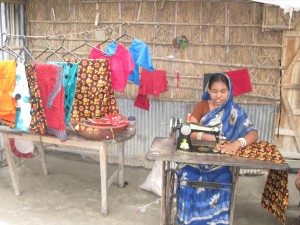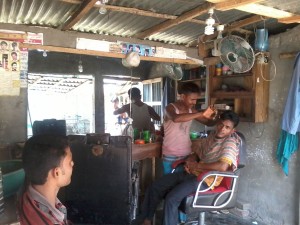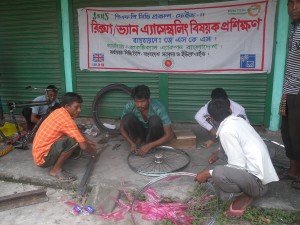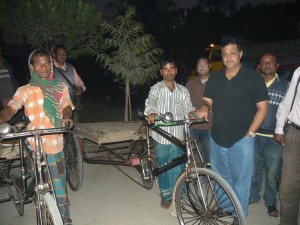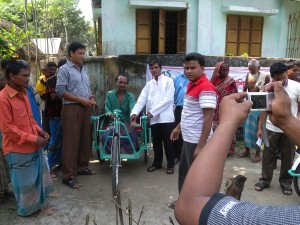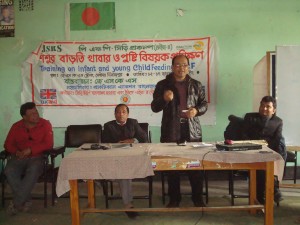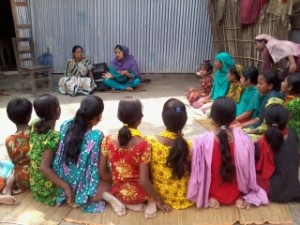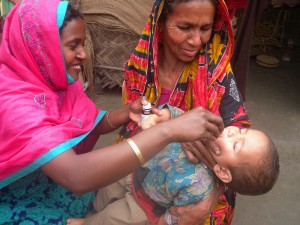Working Area:
| District | Upazila | Union |
| Nilphamari | Dimla | Gayabari |
| Jhunagachh Chapani | ||
| Khalisha Chapani | ||
| Khoga Khoribari | ||
| Paschim Chatnai | ||
| Purbo Chatnai | ||
| Tepa Kharibari | ||
| Jaldhaka | Dawabari | |
| Golmunda | ||
| Kaimari | ||
| Soulmari | ||
| Rangpur | Gangachara | NohaliHighlights by sectorHighlights by sector |
Activities Highlights by Sector:
- Agriculture Sector: Agriculture sector plays a vital role in food production, through ensuring access to common property resources for the displaced communities. Through practicing sand bar cropping in unfertile and barren soil, floating garden during flooding, vegetable production on the slope of the flood protection embankment, households have not only got access to secure food, but also gained earning opportunity by selling their surplus produces in the market. Additionally storage of pumpkins has given them food security during the lean season, particularly in flooding time.
Sandbar Cropping: It is a common phenomenon that the people of river treated area or river eroded area has no cultivable land. When the waters subside, silted sand plains are left behind. These ‘char’ lands are infertile, but ‘sandbar cropping’ is a simple, innovative and very low-cost option: vegetable seeds are planted into a deep pit in the sand, which is filled with compost. Most of the land covered with sand which is not suitable for crop cultivation through traditional way. To ensure the livelihood of the char people sandbar cropping technology is one of the most important technologies to generate income. With this technology char people are cultivated pumpkin to meet their daily nutrients easily. Pumpkins could be preserved for near about a year or more under room temperature which helped in wading through the lean period. They provide nutrition during flood season when no other vegetable can be cultivated.
Vegetables production (Homestead/ Embankment): Vegetable production on the homestead fallow land or embankment slopes is one of the alternative options for food production particularly for the displaced and landless communities. It’s helped extreme poor families in supplying food in the lean seasons for both consumption and sell. During reporting year, total 390 beneficiaries are trained on homestead /embankment vegetable production. JSKS provided inputs support of different vegetables seeds, bucket, mug, bamboo, da, kurpi, cow dung, papaya seedling, guava sapling, apple cul sapling, chili seedling etc as homestead vegetable cultivation inputs. All the beneficiaries has sown vegetables seed in there bed and transplanted the seedlings with proper maintenance.
Floating Vegetable Garden: The floating vegetable garden involves growing vegetables on a floating medium during the flood season which allows farmers to the trial engaging to grow vegetable on flooded land, as well as ponds and other water sources. Simple and relatively inexpensive, a ten by one meter raft is constructed from water hyacinth, a common weed. A layer of soil, compost and manure is then placed on the surface of the raft, in which vegetables are planted.
2. Livestock sector:
Livestock is the promising and attractive sector which can play a vital role to elevate the vulnerability and extreme poverty. It is the key tools for changing the socio economic status as well as livelihoods status of the targeted beneficiaries and assists to build economic resilience.
Working area is so much potential for Sheep rearing but rearing practice is very low among the community people. Have a great feasibility for heifer rearing and beef fattening. Have the unused area for fodder cultivation. Participants for Sheep/ Goat rearing, Duck rearing, Beef fattening or heifer rearing is needed mass vaccination and have a great scope.
Sheep rearing, heifer rearing, vaccination campaign intervention are present in livestock sector. Considering the criteria and opportunity of BHHs, the project is providing support to involve the beneficiaries with these interventions. Intervention wise selected beneficiaries are trained up and then asset transfer.
Sheep rearing: Sheep rearing is the vital occupation for reduction of poverty in case of landless, river eroded bottom 10% extreme poor who are living on embankment and who are target beneficiaries of PFP-shiree project. During this period, JSKS- PFP-shiree project provided 2 days long in nine batches training on sheep rearing and management to the target beneficiaries. DLS personnel were present in the training session that encourages the beneficiaries. During the training session discussed topics were about objectives of training, role of sheep rearing for poverty reduction, breed of sheep, health management, housing management, feeding, reproduction, treatment and prevention of different diseases etc.
Heifer rearing: Heifer rearing is the promising and attractive intervention of income generating activities (IGAs) which can play a vital role to elevate the vulnerability and extreme poverty. It is the key tools for changing the socio-economic status as well as livelihoods status of the targeted beneficiaries and assists to build economic resilience.
3. Fisheries Sector:
The fisheries sector provides livelihoods and income to the vast majority of the poor in Bangladesh. It plays a particularly important role among disadvantaged groups as a main or supplementary source of employment, livelihood and income. Most Bangladeshi poor live in rural areas with very limited employment opportunities. Fully 73% of rural households are involved in some kind of freshwater aquaculture on the floodplains throughout the country. Job growth in manufacturing, construction and power generation and services has absorbed many workers but has not kept pace with an ever-expanding workforce. The fisheries sector is the second largest part-time and full-time employer in rural areas, directly engaging over 60% of the rural population, as estimated based on agriculture census data (BBS 1999). An estimated 1.2 million people are directly employed in this sector. A further 12 million rural people indirectly earn livelihood from fisheries-related activities, such as the downstream activities of fish trading and processing (Dey et al. 2008a). Besides capture fisheries, aquaculture can open up new employment opportunities in rural areas by increasing both self-employment and demand for hired labor.
Cage Aquaculture: To ensure the livelihood of the embankments people cage aquaculture is one of the most important technologies to generate income and met up protein deficiency. With these technologies river eroded people are culture fish to meet their daily nutrition easily.
Traditional Fishermen: Fishermen in rural Bangladesh usually live a community life in neighborhoods or villages around the water bodies. They cooperate closely with one another not only in fishing, or in the cooperative utilization of fishing grounds, but also in economic activities, such as marketing and purchasing, and in social life and family affairs. They have lived communally for many generations, creating in the process their own history, distinct traditions, and patterns of daily life. To ensure the livelihood of the embankments people traditional fisherman is one of the most important technologies to generate income and met up protein deficiency.
Community Based Fisheries Management (CBFM): The community based fisheries management (CBFM) initiative has developed a series of management approaches for ensuring equitable access to fisheries resources. Community Based Fisheries Management (CBFM) is one of the most successful Income Generating Activities (IGAs) to the embankment people.
Small and Medium Enterprise (SME) sector:
Small Enterprise (SME) is a promising sector to develop entrepreneurs in the PFP shiree project. This sector aims to develop entrepreneurs in different sub-sector i.e. tailoring, weaving, handicraft and small trade. These interventions will be used to graduate the vulnerable/extreme poor household by providing training and input support so that they can continue it in a sustainable manner. Generally this sector is emphasized to empower the women.
Tailoring master development: 10 days long residential training on tailoring mastering was provided to the beneficiaries’. The training events were to operate tailor machine, dress making, management of the machine and other necessary techniques to carry out their activities smoothly. After training each beneficiaries received inputs of one Butterfly sewing machine, scissor, tape, cloth etc. So, that they can start their business smoothly. Now the beneficiaries are able to making at least 6 types of different dresses for both men and women.
Small trade: For generating the income of river eroded BHHs, small trade is one of vital the intervention. In this intervention the beneficiaries were selected considering the criteria of existing small business such as grocery, ferry, toiletries, betel leaf and nut, rice etc.
Food Processing Sector:
For generating the income of river eroded BHHs, food processing is one of the intervention. In this intervention the beneficiaries were selected considering the criteria of interest in food processing business, hotel workers in food items production, have experience in small scale food processing and marketing, physically active one or more family member etc.
LIGHT-ENGINEERING SECTOR:
The light engineering is of the prominent income generating activities (IGAs) which can play a vital role to elevate the vulnerability and extreme poverty. It is the key tools for changing the socio-economic status as well as livelihoods status of the extreme poor and assists to build economic resilience. Its objective is to create alternative income opportunity and diversified jobs for the unemployed youths in the project locations. Under this sector the interventions are Rickshaw/van repairing, welding, boat engine repairing etc.
Other Activities:
Capacity building training to the Disable beneficiaries: There are some peoples with disabilities has been found in Dimla and Jhaldhaka upazilla. To secure the disable peoples livelihood and aware about their rights, JSKS-PFP-shiree project provided capacity building training to 30 beneficiaries. After completing training, PAB personnel assessment the participants and recommend relevant assistive device for disable beneficiaries. The PwD BHHs received Physiotherapeutic treatment, hearing test/treatment and visual assessment/treatment respectively and go Assistive devices as per assessment and requirement.
Access to Khash land workshop: In order to established access to khash land for sandbar cropping of PFP BHHs of char areas, the project has organized Upazila and union level land identification workshop. The main objective of this workshop was to find out the khash land and its distribution to the right person and accordingly reduce the food insecurity of extreme poor people. It also helped them to reduce social injustice & establish human rights in the society. To strengthen the process JSKS conducted Upazila and union level workshop, with the facilitation of Director (JSKS), PAB personnel, UP Chairman, Upazila Chairman, UNO, Upazila Agriculture officer, Upazila Livestock officer, Fisheries officer and land owner and the community people. In this reporting period, JSKS-PFP-shiree Project has been organized 04 union level workshops in their working area.
Regarding the workshop benefits it is found that landless to land ownership which enhanced the participants moral courage, landless people of the community to change their livelihood by getting land and sandbar cropping easily are adopted by cultivating the Khash land. It is challenging that land owner have the tendency to capture his/her land that hampered to established the right of landless people. Our recommendation is there needs more coordination with Upazila parishad, Union parishad, land owner, service providers, elite and market players to succeed the activity
Formation of pumpkin Associations: Three Pumpkin producer Association was formed in three different Upazila in considering sandbar location.. One at tepakhoribari union in Dimla upazila. Second producer Association at Banpara in Jaldhaka Upazila & another association at Nohali union in Gangachora Upazila. The main objective of this association is to make effective linkage with market players and looking suitable market and player for selling their pumpkin in profitable rate. They get together in monthly and discussion on their problem and probable solution on pumpkin.
Nutrition Component:
JSKS is working closely with stakeholders such as community people, Traditional Birth Attendance (TBA), Village Doctors, Religious Leaders, local government e.g. union council members, government departments, research and academic institutions, national project of nutrition, networks including relevant others. Nutrition is required to improve the health status of all extreme poor BHHs and their dependents of PFP project. It is possible both by increasing and utilization proper balanced diet, provide micro-nutrient supplement, de-worming tablets, suspension, IFA etc. particularly to the pregnant women, lactating mothers, children and adolescents as well as all family members. The expected result of this nutrition project is to increase the nutritional and health status of extreme poor women and their dependents e.g. children and adolescent girls. It is understood from previous project experiences that increase of productivity alone does not increase the food utilization and meet up nutrition status of the extreme poor BHHs. Therefore, it requires other issues to be taken into consideration as promotion of small scale homestead vegetable and fruits gardening, safe drinking water, hygiene, sanitation, proper storing, preservation and processing to overcome the lean period.The project targets to improve nutritional status of all PFP project BHHs 4482 of JSKS in Nilphamari district where consumption of required fish, meat, milk, egg, fruit, vegetable and pulse are very less specifically in the monga (lean) period i.e. February-April and October-November respectively. The nutrition project is link with the existing practices of homestead gardening, sandbar cropping, fish culture, duck and poultry farming, cow, goat and sheep rearing to increase the intake of food. Knowledge on nutritional education, safe food preparation, behavioural change and homestead gardening will increase the health status of the project BHHs as well as the community at large. It has planned to introduce the dietary diversification through trainings, demonstration, and awareness campaign, printed and electronic materials and motivational works.


